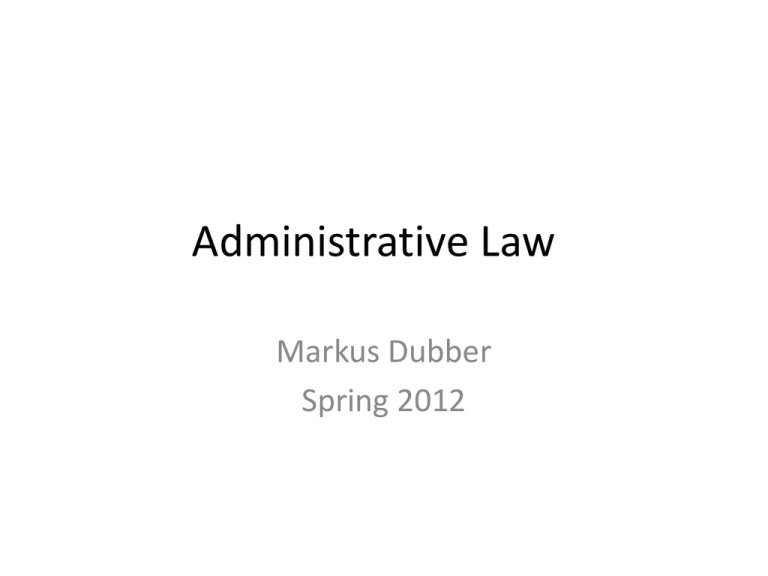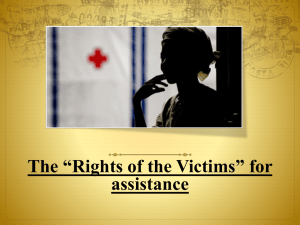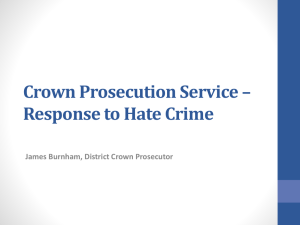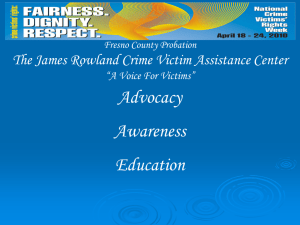
Administrative Law
Markus Dubber
Spring 2012
CICB, not CIBC
CICB: Cogan (Ont Divisional Ct ‘92)
• Claim
– July 30, 89: assault at home (pushed down flight of stairs)
– June 19, 90: purse snatch attempt on street
• Comp for Victims of Crime Act
s. 23: Board decision final “except that an appeal lies to the Divisional Court from any
decision of the Board on any question of law”
s. 19(1) The amount awarded by the Board to be paid in respect of the injury or death of
one victim shall not exceed, (a) in the case of lump sum payments, $25,000; and (b) in
the case of periodic payments, $1,000 per month, and where both lump sum and
periodic payments are awarded, the lump sum shall not exceed half of the maximum
therefor prescribed in clause (a).
(2) The total amount awarded by the Board to be paid to all applicants in respect of any one
occurrence shall not exceed, (a) in the case of lump sum payments, a total of $150,000;
and (b) in the case of periodic payments, a total of $250,000. …
(4) For the purposes of this section, the Board may deem more than one act to be one
occurrence where the acts have a common relationship in time and place.
• Illegal self-fetter: $25,000 lid
– Claimed loss: $70,510.00 (“well beyond the admissible allowed…”)
– $25,000 per victim vs. per crime per victim
THAT Mrs. Tait [chair] appeared to be very adversarial, particularly when Mr. Hill stood by
his submission. Mrs. Tait told Mr. Hill that Board policy prevented her from doing this. …
THAT the member, Piara Sahota, seemed at one point to agree with Mr. Hill's submission,
and this seemed to upset Mrs. Tait who said to Piara Sahota, through her teeth, "policy,
Mr. Sahota, policy".
CICB: Leung (Ont Divisional Ct ‘95)
• Guideline:
Board approach used in
calculating pecuniary losses sustained under Section 7(1)(b)
In calculating pecuniary loss under section 7(1)(b), in a manner which treats all applicants
with long or short term injury related disabilities in the same fashion, the Board shall
generally multiply the number of usual working days contained in the period of
disability (to a maximum of 5 days per week and twenty days per month) by the amount
of $50.00 and will subtract from that sum any employment-related benefits, indemnity
or compensation paid or payable pertaining to that period and any income received or
to be received from alternate employment for that period.
• Unlawful fetter? [Evans in de Smith’s Judicial Review of Admin Action 4th ed.!]
– “A tribunal entrusted with a discretion must not by the adoption of a fixed rule
of policy, disable itself from exercising its discretion in individual cases.”
– “pursuit of consistency at the expense of the merits of individual cases”
• Using discretion not to use discretion
• not enough discretion!
• Sentencing guidelines…
• YES!
– Although the word "generally" is employed in the guideline, the effect of the
guideline is to encourage an arbitrary and even capricious treatment of victims
of crime. It cannot be argued that this type of guideline in any way reflects the
intention of the legislature.
Leung 2
• BUT: no reasons!
– Separate ground of appeal!
• No problem—only required to give reasons “if
requested by a party”!!
– Leung never asked for reasons!!
– b/c no reasons, unclear why the Board limited wage loss
award to $2,000!
• Therefore, insufficient evidence that Board applied guideline
• Therefore, insufficient evidence that Board in fact fettered its
discretion by applying the guideline
• Given the material that was before the Board, particularly in relation
to the medical evidence, it cannot be said that the Board exercised
its discretion unreasonably in limiting the wage loss award to $2,000
quite apart from the application of the wage loss guideline.
• “It would have been desirable for the Board to have given some
reasons for limiting the award for wage loss in order to avoid the
victim feeling … ‘that he has been the victim of an arbitrary
decision’.” !!
CICB: Pitters (Ont Divisional Ct ‘96)
• Gun play results in serious injury
• Charged with use, possession, negligent assault
– Pleads guilty to possession; 2 months
• No compensation b/c “accident,” not “crime of violence”
– Is “possession” (rather than use) a crime of violence?
– Balance of probabilities
• (1) Finding of “accident”
– Not cognizable on appeal, not question of law
• (2) Interpretation of “crime of violence” (s. 5(4))
– The meaning of "a crime of violence” must be ascertained from s.
5(a) of the Act, and the general principles of statutory
construction…
• No definition in definitional section
• Context, purpose…
Crime of violence?
• Everyday people/plain meaning
– “Violence” is used in a descriptive sense to designate the type of crime that
must be proven to permit the Board to consider the exercise of its
discretion to award compensation. A "crime of violence" is a crime of a
violent kind. In everyday usage, "violence" connotes the exercise of a
physical force so as to inflict injury or damage to persons or property.
"Violent" includes intense, vehement, very strong or severe. It is
characterized by the doing of harm or injury. It includes impetuous. In
ordinary speech, "violent" includes, but is not synonymous with the use of
physical force.
– Legislature didn’t limit plain meaning (unlike elsewhere)
•
Intent or recklessness re: death/other harm
– The Brits have a hard time defining crime of violence, too…
– Appears nowhere in Criminal Code…
– Luckily, we don’t have to “mark the limits of the inscrutable phrase ‘a crime
of violence,” b/c s. 5(a) provides compensation for injuries resulting from:
•
the commission of a crime of violence constituting an offence against the Criminal
Code (Canada), including … an offence under section 86
Crime of Violence: The Resolution
86. (2) Every one who, without lawful excuse, uses, carries, handles,
ships or stores any firearm or ammunition in a careless manner or
without reasonable precautions for the safety of other persons (a)
is guilty of an indictable offence and liable to imprisonment …; or
(b) is guilty of an offence punishable on summary conviction.
• “Mens rea” requires marked departure from standard of care of
reasonable person under circumstances: B.I.N.G.O.
– Therefore—”crime of violence”—compensability
• Don’t fetter yourself—confidence, confidence!
“Under the legislation, it is the Board that is required to decide whether a
relevant offence, "a crime of violence", has taken place. The matter is
not determined by the initial categorization of the offence by police
investigators. It is not decided by the charge(s) laid against an offender.
It is not resolved by the charge(s) upon which the prosecutor chooses to
proceed to trial or other disposition. It is not pre-empted by the decision
of the criminal court. It is for the Board to decide the matter, on the
evidence adduced before it, and upon proper construction of its
statutory mandate.”
Masakeyash (Ont Divisional Ct ’06)
• Child’s play; slingshot; stone in the eye; infant offender (and victim—on
behalf of Jamie Skunk…)
• Board: no crime of violence b/c no intent
• CICB: “alleged offender” incapable of criminal responsibility (infant)
• Standard of review!!! (correctness)
• s. 13 Criminal Code: No person shall be convicted of an offence in respect of
an act or omission on his part while that person was under the age of
twelve years.
• s. 16(2) CICB Act: Even though a person for any reason is legally incapable of
forming criminal intent, the person shall, for the purposes of this Act, be
deemed to have intended an act or omission that caused injury or death for
which compensation is payable under this Act.
– CICB: 16(2) trumps 13 CC; irrebuttable presumption of intent (mens rea) for
infant upon proof of actus reus
• Ct: 13 not limited to intent, but blanket exemption from “criminal
accountability” (even in the presence of intent…); “moral innocence”
(children’s incapacity “to fully understand the nature of their conduct or the
risks and dangers inherent in their actions or that their conduct is
blameworthy”)
Ad absurdum
There are practical difficulties in the interpretation of the Act put forward by
appellant's counsel.
Any violent act by a child would be deemed to be a crime, not an accident, and
compensation would be payable, while the same act committed by an adult
might amount to only civil negligence or pure accident. This would be
contrary to the intention of the Act to compensate for crimes of [adult?]
violence. [?] [vs. torts?]
Theoretically at least, compensation would be awarded not only for the usual
schoolyard confrontations and accidents but also as a result of innocent
aggression by the youngest of infants.
The results of a compensation order made in relation to an infant would not
necessarily be benign. The infant would carry the stigma of having
committed a crime of violence and by s. 26(2) of the Act the Board may
pursue a subrogated proceeding against the "offender" to recover the
compensation paid and the costs.
I conclude it was not the intent of the legislature in enacting s. 16(2) to
displace the effect of Criminal Code, s. 13 that children under 12 are
incapable of committing crimes. Compensation, therefore, may not be
awarded as a result of the conduct of children under the age of 12 years.
- what, then is the point of CIBC 16(2)? Intoxication?
Dalton (Ont Div Ct ‘82)
• Woman meets men in bar; gets in van; sexual advances; pushed out; serious
injuries
• s. 17(1) In determining whether to make an order for compensation and the
amount thereof, Board shall have regard to all relevant circumstances,
including any behaviour of the victim that may have directly or indirectly
contribute to his injury or death.
– formerly: “the Board may have regard to all such circumstances as it considers
relevant”
• In view of the fact that the applicant had consumed a fair amount of alcohol
whereby her judgment was impaired and that the two unknown alleged
offenders had also had a considerable amount to drink, in the Board's
opinion, it was imprudent to go into a van with two unknown inebriated
men and the Board concludes that the applicant was the author of her own
misfortune ...
• Review of law only, not fact (e.g., of drunkenness, familiarity, politeness)
– 17(1) errors:
• failure to consider “all relevant circumstances,” to wit, severity of injuries
• Victim contributing, but not sole, cause of her misfortune
Skerget (Ont Div Ct ‘77)
• Acquitted of assault
• Neither prosecution nor conviction required
– The legislation is understandably silent as to the effect
to be given to an acquittal on a particular charge
because of the fact that neither prosecution nor
conviction of an offence is a necessary prerequisite to
compensation…
• “evidence may be adduced different from that
adduced in the criminal Court”
– Rules of evidence, what rules of evidence?
– Burden of proof
• balance of probabilities vs. beyond reasonable doubt
Jane Doe (Ont. Div. Ct ‘95)
•
•
•
•
CICB version of R. v. Cuerrier [1998] 2 S.C.R. 371 (fraudulently obtained consent)
Tried for criminal negligence causing bodily harm; dies of AIDS
Reduced award from max 25 to 15k
17(1) again: In determining whether to make an order for compensation and the
amount thereof, Board shall have regard to all relevant circumstances, including
any behaviour of the victim that may have directly or indirectly contribute to his
injury or death.
• Atty Gen (for victims):
– contributory behaviour = contributory negligence
• Foreseeability
– Unforeseeability of dishonesty re: HIV (citing Dalton)
• Standard of care
– No “flagrant, reckless or foolish disregard for safety”
– No evidence re: knowledge of dangers of contracting AIDS in late
80s/earler 90s
• Causation
– Offender sole cause
– Failure to consider all relevant circumstances
• Board considered “moral code” (in relying on sex after “a brief
acquaintance”)
Jane Doe 2
• CICB
– No right to compensation; untrammeled jurisdiction unless
arbitrary
– Unreviewable issue of fact
• Ct:
– Victim compensation is not tort law
• Negligence analysis inapposite
– Whether “the board erred in law in finding that the behaviour of
the victims directly or indirectly contributed to their injuries”
• Demanded unreasonably high standard
– Public awareness of risk in 1991? Actual awareness?
• Overwhelming consequences; proportionality of O’s conduct vs. V’s lack of
prudence
– “In our opinion the board demonstrated a clear and identifiable
error of fact in its appreciation of the evidence which is
tantamount to a material and identifiable error of law.”
Spade Ont. Div. Ct. ‘90
• Marjorie Spade tries to stop fight b/w two men; injured
• CICB: no “crime of violence as envisaged” by s. 5(a)
– Correct? no
• Jobidon [!] (after board decision): no consent to assault
w/ intent to harm or actual harm
• Participants in fights committed assault within the
provisions of the Criminal Code and “in the process, the
applicant was injured as envisaged by s. 5(a)”
– 5. Where any person is injured or killed by any act or
omission in Ontario of any other person occurring in or
resulting from (a) the commission of a crime of violence
constituting an offence against the Criminal Code
Manson Ont. Div. Ct. ‘89
• Drinking, Key shows off gun, playing craps at 2:45am, Pieluch
and Key argue, Key takes money and walks off, Manson tells
Key he’s wrong, Key holds gun to Manson’s head and
threatens to kill him, Manson insists, and again—Key shoots
him in the arm…
• CICB: no award 17(1) (contribution)
– Under either 5(a) or 5(c) (prevention)
• Court
– No right to compensation
– Distinguishes Dalton, where the victim “could not have expected”
injury suffered
– “flagrant, reckless, or foolish disregard for his own safety”
– “It is not necessary to find the appellant ‘culpable’ in the sense of
wrongdoing … [nor] to find him the complete author of his own
misfortune” (contributing cause enough)
Fregeau Ont Div Ct ‘73
• Firefighter w/ severe injuries
• No award because dismissal of attempted
insurance fraud
• Failure to consider underlying arson as crime
of violence
– Quashed, regrettably
– “To fail to consider the only material evidence of
crime was an error of law ….”
Stone Ont Div Ct ‘82
• No award for drug dealer
• The information before the Board “could
reasonably have led the Board to think that
the assault was an incident of the carrying
out, by the appellant, of activities in the illicit
drug trade”
• 17(1)!
Sheehan Ont Div Ct ‘73
• Sheehan
– Assault by fellow prisoner ‘70
– Assault during Kingston riots ‘71
• 4 other inmates & 1 guard
• Denied
– Criminal behaviour: “but for their own prior criminal
activity”
• Irrelevant b/c unconnected
– Federal (not provincial) prisons
• Exclusion of federal prison inmates from crime victim
compensation; not legislative intent…
• Board decision overturned
– Irrelevant considerations
– Even “ex gratia” payment, without legal obligation, subject
to judicial review
Sheehan 2 Ont Ct Appeal [!!] ‘75
• Limited judicial review under [old] statute
– [former] 3. “… the decision of the Board is final and conclusive for
all purposes”
• [current] 23. “… a decision of the Board is final except that an appeal lies to
the Divisional Court from any decision of the Board on any question of law”
– [former] 5. In determining whether to make an order for
compensation and the amount thereof, the Board may have
regard to all such circumstances as it considers relevant, including
any behaviour of the victim that directly or indirectly contributed
to his injury or death”
• [current] 17(1). “In determining whether to make an order for
compensation and the amount thereof, the Board shall have regard to all
relevant circumstances, including any behaviour of the victim that may
have directly or indirectly contributed to his or her injury or death”
• Failure to consider all and only relevant considerations or considerations
beside the point [unless factors “patently irrelevant”]
• Affirm Board decision; overturn Div Ct!










